TAXANGLES A newsletter for proactive planning... In this edition... April 2021 Issue www.compassaccountants.co.uk Personal and family companies – Optimal salary for 2021/22 Take advantage of the enhanced carry back of losses Super-deduction for capital expenditure Further grants for the self-employed Tax allowances frozen until April 2026 My journey in accountancy - Sarah McInnes 10 Questions with.... Compass Accountant's Louise Edwards

PAGE 2 Personal and family companies – Optimal salary for 2021/22 A popular profit extraction strategy for shareholders in personal and family companies is to pay a small salary and to extract further profits as dividends. The optimal salary will depend on whether the employment allowance is available to shelter any employer’s National Insurance liability that may arise. Preserving pension entitlement One of the main advantages of paying a small salary is to ensure that the year remains a qualifying year for state pension and contributory benefit purposes. To qualify for a full state pension on retirement, an individual needs 35 qualifying years. For the year to be a qualifying year, earnings must be at least equal to the lower earnings limit. A director has an annual earnings limit, and for 2021/22, the annual lower earnings limit is set at £6,240. Where the shareholder is not a director, earnings for each earnings period must be at least equal to the lower earnings limit. For 2021/22, the weekly and monthly thresholds are, respectively, £120 and £520. Contributions are payable by the employee at a notional zero rate on earnings between the lower earnings limit and the primary thresholds. The employee starts paying contributions once earnings exceed the primary threshold. Optimal salary – Employment allowance is not available The employment allowance is not available to companies where the sole employee is also a director. This means that personal companies will generally be unable to claim the allowance. For 2021/22, the primary threshold is set at £9,558 (£184 per week/£797 per month) and the secondary threshold is set at £8,840 (£170 per week, £737 per month). Although the maximum salary that can be paid without paying any National Insurance is one equal to the secondary threshold of £8,840 for 2021/22, it is beneficial to pay a higher salary equal to the primary threshold of £9,568. Employer’s National Insurance will be payable on the salary to the extent that it exceeds £8,840 at a cost of £100.46 (13.8% (£9,568 - £8,840)), however, this is outweighed by the corporation tax deduction at 19% on the additional salary and the employer’s NIC. Once the primary threshold is reached, employee contributions are payable at 12%. At this point, the combined National Insurance cost of 25.8% (13.8% + 12%) is more than the corporation tax saving and paying a salary in excess of the primary threshold is not worthwhile. Thus, where the employment allowance is not available, the optimal salary is equal to the primary threshold for 2021/22 of £9,568 (£184 per week, £797 per month). Optimal salary - Employment allowance is available In a family company scenario, the employment allowance will be available if there is more than one employee on the payroll. As long as the employment allowance is available to shelter the employer’s National Insurance that would otherwise arise, the optimal salary is one equal to the personal allowance, set at £12,570 for 2021/22. No National Insurance is payable until the primary threshold is reached. Above this level, employee National Insurance is payable at the rate of 12%. However, the additional salary saves corporation tax at 19%. However, once the personal allowance has been used, tax at 20% is payable as well as employee’s National Insurance of 12%, which exceed the corporation tax deduction of 19%. Thus, where the employment allowance is available, the optimal salary for 2021/22 is one equal to the personal allowance of £12,570 (£242 per week, £1,048 per month).
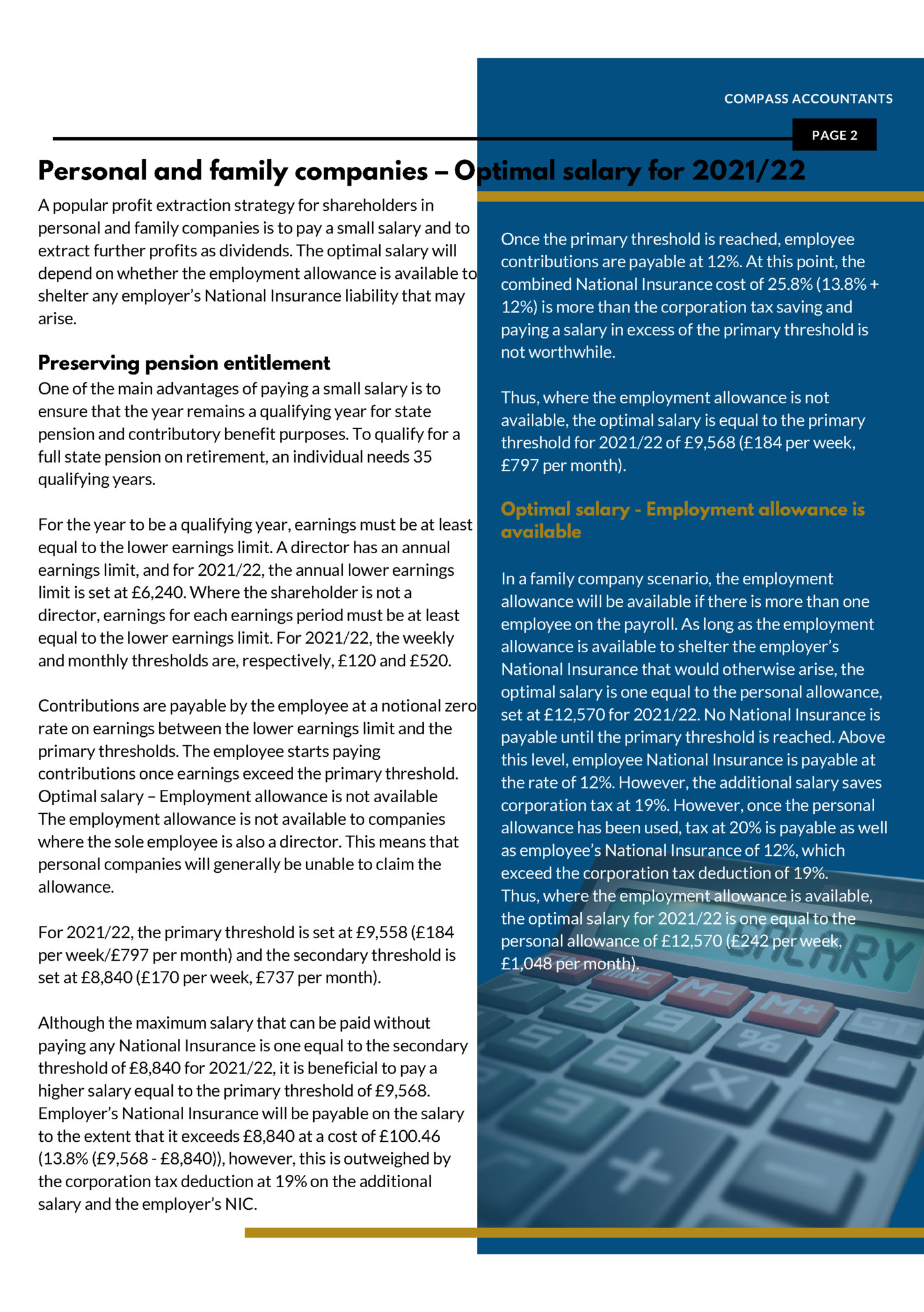
PAGE 3 Take advantage of the enhanced carry back of losses Many businesses have suffered losses as a result of the Covid-19 pandemic, and where a business has made a loss, various options are available to obtain relief for that loss. The challenge is to make the best use of the loss. To help loss-making businesses, legislation is to be introduced to increase temporarily the period for which a business can carry back a loss from one year to three years. The extended carry back is available to both unincorporated business and companies, and can be used to generate a useful tax repayment at a time when cash flow is tight. Unincorporated businesses Under the existing rules, a person who incurs a trading loss in a tax year can make a claim to offset the loss of their net income of the current year, the previous year or both years. This option is now available to traders using the cash basis. For a limited period, the carry-back period will be extended, and losses can be carried back and set against trading profits of the previous three years. from one. Losses carried back must be set against the income of a later year before an earlier year. The extended carry back will apply to losses in 2020/21 and 2021/22. It will enable a loss for 2021/22 to be carried back where a loss was also made in 2020/21 and the individual had no other income for that year. Example Lottie is a beautician. She prepares accounts to 31 March each year. For the year to 31 March 2021, she made a loss of £12,000. It is assumed that she made a loss of £7,000 for the year to 31 March 2022. She had trading profits of £27,000 in 2019/20, £20,000 in 2018/19 and £16,000 is 2017/18. She carries the loss of £12,000 back to 2019/20 reducing her profits to £15,000 for that year and generating a tax repayment of £2,400 (£12,000 @ 20%). In the absence of the extended carry back, if she had no other income (or gains) for 2021/22 and no income for 2020/21, Lottie would have to carry the loss from 2021/22 forward to set against other profits from the same trade. Cont on pg 4

PAGE 4 However, the extended carry-back allows her to carry the loss back to set against trading profits of 2019/20. Although, this will reduce her profits to £10,000, which is below the personal allowance for that year of £12,500, it will generate a tax repayment of £500 (£2,500 @ 20%), which may be useful. As the loss cannot be tailored to preserve the personal allowance, if she does not want to waste any of her personal allowance for 2019/20, she can instead carry the 2021/22 loss forward. Companies The extended carry back also applies for corporation tax purposes for losses incurred in accounting periods ending between 1 April 2020 and 31 March 2021 and losses incurred in accounting periods ending between 1 April 2021 and 31 March 2022. For corporation tax purposes, losses can be carried back to the preceding accounting period. Where the extended carry-back applies, a loss can be carried back and set against profits of the same trade for the preceding year and two previous years, with losses being set against a later year before an earlier year. Example ABC Ltd makes a loss of £40,000 for the year to 31 January 2021 and a loss of £25,000 for the year to 31 January 2022. The company made a profit of £30,000 for the year to 31 January 2020, a profit of £50,000 for the year to 31 January 2019 and a profit of £42,000 for the year to 31 January 2018. The loss for the year to 31 January 2021 is carried back and set against the profit of £30,000 for the year to 31 January 2020, with the remaining £10,000 set against the profit of £50,000 for the year to 31 January 2019, reducing it to £40,000. This generates a corporation tax repayment of £7,600 (£40,000 @ 19%). The loss of £25,000 for the year to 31 January 2022 is carried back and set against the remaining profits for the year to 31 January 2019, reducing them to £15,000. This generates a tax repayment of £5,000 (£25,000 @20%). Without the extended carry back, it would only have been possible to carry-back £30,000 of the loss for the year to 31 January 2021, reducing the repayment to £5,700. Using the extended carry back increases the total repayment by £6,900.
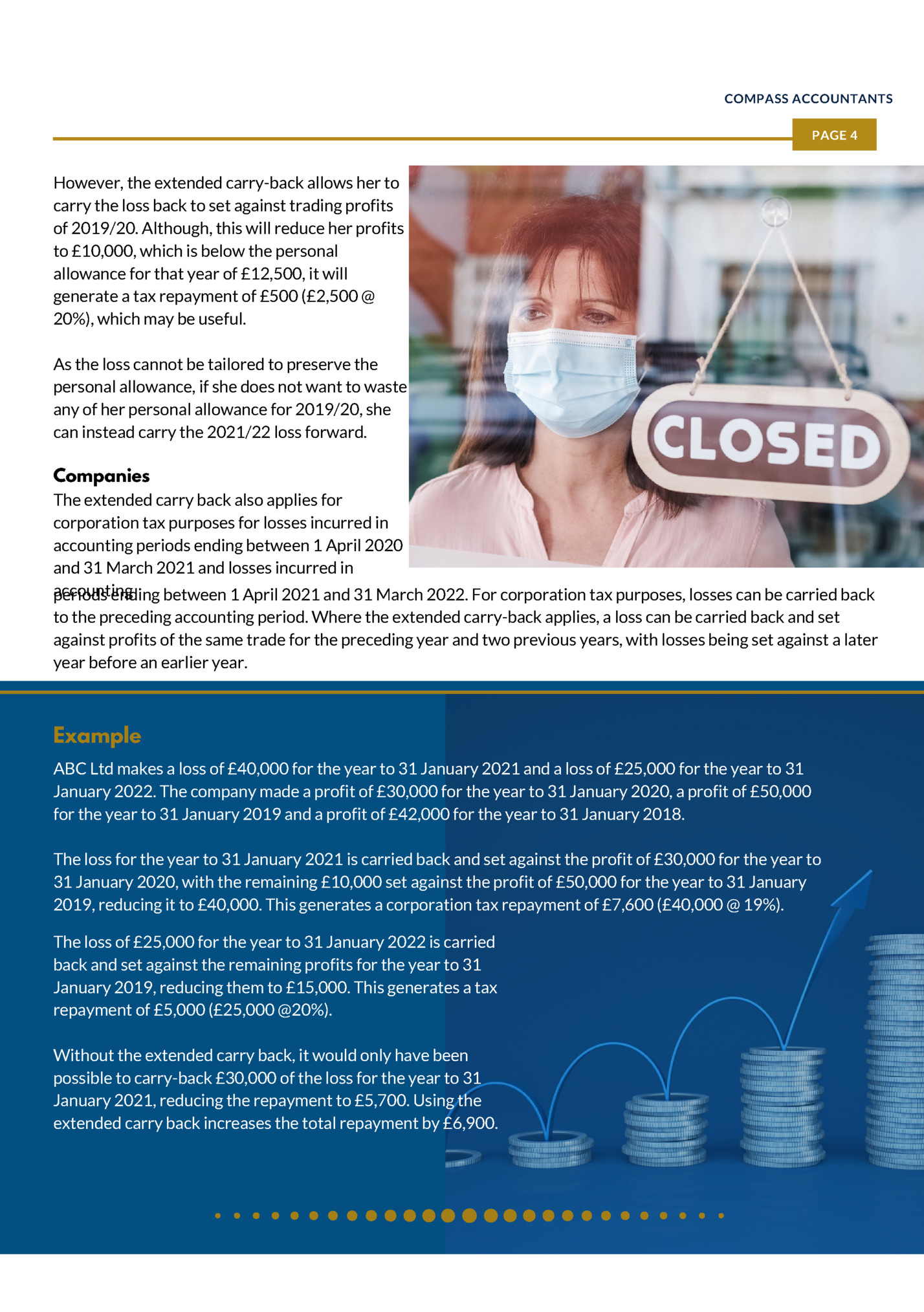
Super-deduction for capital expenditure To encourage companies to invest, enhanced capital allowances are available for expenditure incurred within a limited two-year window. As an alternative to the annual investment allowance (AIA), companies will be able to benefit from either a superdeduction or a new first-year allowance, depending on whether the expenditure is on assets that would qualify for main rate capital allowance or for special rate capital allowances. Super-deduction The super-deduction will allow companies to claim capital allowances of 130% for expenditure on new assets that would otherwise qualify for main rate (18%) plant and machinery capital allowances where the expenditure is incurred in the period from 1 April 2021 to 31 March 2023. The super-deduction does not apply where the contract for the asset was entered into prior to 3 March 2021 (Budget Day), even if the expenditure is incurred in the qualifying two-year period. Plant and machinery which is purchased under Hire Purchase or similar contracts must meet additional conditions in order to qualify for the super-deduction. Where an accounting period straddles 1 April 2023, the rate of deduction is apportioned based on the number of days in the accounting period falling before 1 April 2023 and the number of days in the accounting period falling on or after this date. The effect of the super-deduction is that for every £100 of expenditure on qualifying assets in the qualifying period, the company can claim capital allowances of £130 when computing taxable profits. This gives an effective rate of relief of 24.7% (130% x 19%). Where an asset which has benefited from the super-deduction has been sold, disposal receipts are treated as balancing charges rather than being taken to pools. A factor of 1.3 is applied to the disposal receipt when calculating the balancing charge. Companies wishing to benefit from the super-deduction should plan the timing of investments in qualifying assets so that the expenditure is incurred in the qualifying two-year period. Where significant investment is planned after 1 April 2023, consideration could be given to accelerating the investment to benefit from the super-deduction. A company does not have to claim the super-deduction. Where the company is loss-making or profits are low, it may wish to claim writing down allowances instead or tailor the claim to reduce the profit to nil. Likewise, if the plan is to sell the asset in a few years, it may be preferable to claim writing down allowances rather than suffer the balancing charge on the disposal. New first-year allowance A new first-year allowance of 50% is available for expenditure on most new plant and machinery that would otherwise qualify for special rate writing down allowances of 6% where the expenditure is incurred in the period 1 April 2021 to 31 March 2023. As with the super-deduction, it is only available to companies. This is an alternative to the annual investment allowance, which gives a deduction of 100%. However, the first-year allowance may be beneficial where the AIA limit has already been reached.
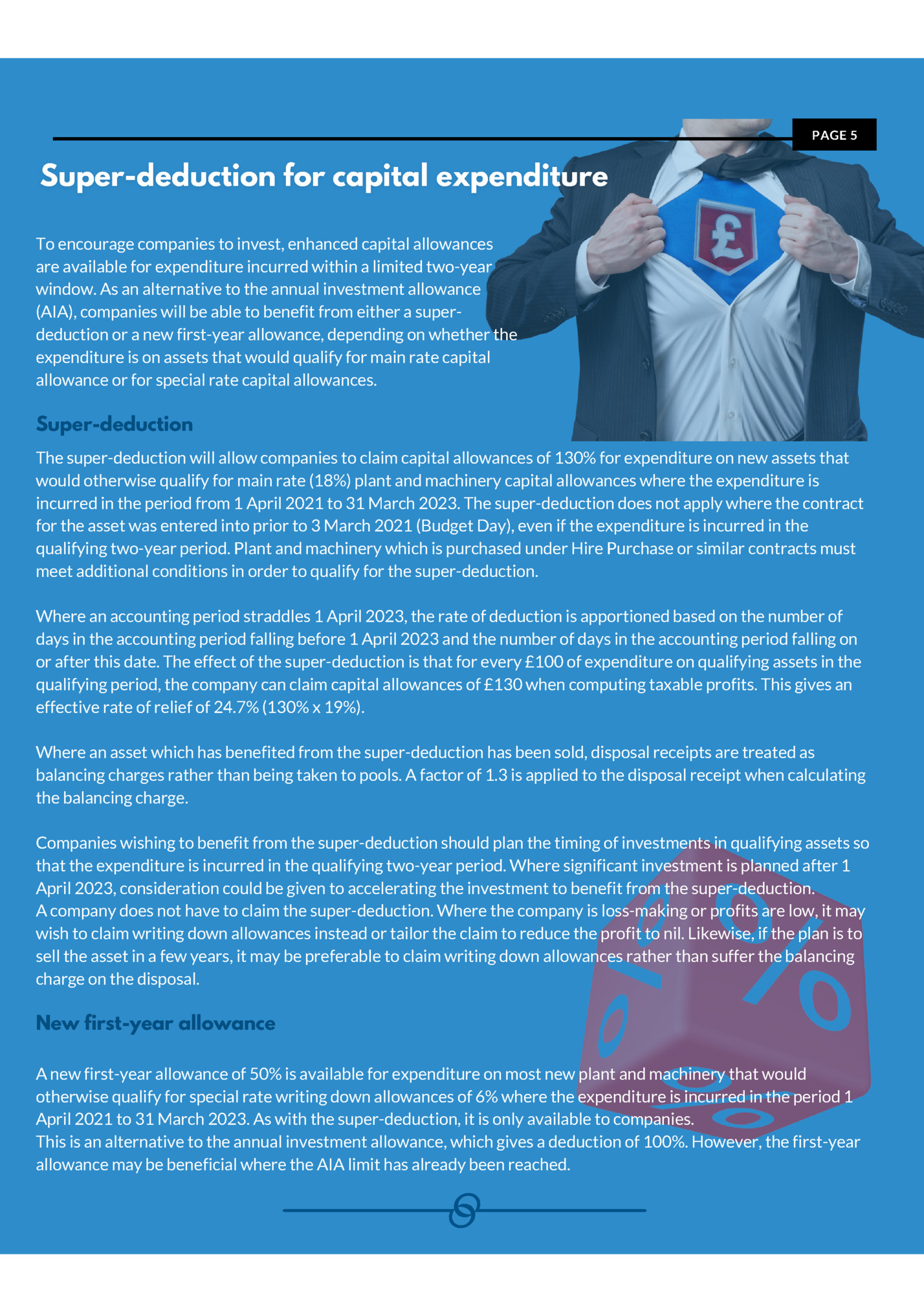
PAGE 6 Further grants for the self-employed The Self-Employment Income Support Scheme (SEISS) has provided grant support for self-employed individuals whose business has been adversely affected by the Covid-19 pandemic. An extension to the scheme was announced at the time of the 2021 Budget. As a result, it will continue to provide support until September 2021. Three grants have already been made under the scheme. As a result of the extension, a further two grants will be available. In addition, individuals who started trading in 2019/20 may now be eligible to claim. Fourth grant The fourth grant covers the period from February to April 2021 and is based on 80% of three months’ average trading profits. The amount of the grant is capped at £7,500. It is paid out in a single instalment. To be eligible, the trader must have filed his or her 2019/20 selfassessment tax return and traded in 2020/21. Only traders whose trading profit is not more than £50,000 in 2019/20 or, where trading profit exceeds this level in 2019/20, not more than £50,000 on average over the period from 2016/17 to 2019/20 can benefit from the grant. In addition, income from selfemployment must account for at least 50% of the individual’s total income. To qualify for the grant, the trader must either: be trading currently but demand has fallen as a result of the impact of the Covid-19 pandemic; or have been trading but is unable to do so temporarily as a result of the Covid-19 pandemic. The trader must also declare that: they intend to continue trading; and they reasonably believe that there will be a significant reduction in their trading profits due to reduced business activity, capacity, demand or inability to trade due to Coronavirus. Claims for the fourth grant can be made online from late April 2021 until 31 May 2021. Fifth grant The fifth and final grant will cover the period from May to September 2021. The amount of this grant depends on the extent by which turnover has fallen as a result of the Covid-19 pandemic. Traders who have suffered a reduction in turnover of at least 30% will be eligible for a grant worth 80% of three months’ average trading profits capped at £7,500. A smaller grant worth 30% of three months’ average trading profits capped at £2,850 will be available to traders who turnover has fallen as a result of coronavirus but where the reduction in turnover is less than 30%. Newly self-employed When the SEISS was originally launched, only those traders who had filed their 2018/19 tax return by 23 April 2020 could claim. As the filing date for the 2019/20 tax return of 31 January 2021 has now passed, individuals who commenced trading in 2019/20 and who have been adversely affected by the Covid-19 pandemic can claim the fourth and fifth grants under the scheme provided that they had filed their 2019/20 self-assessment return by midnight on 2 March 2021. They will also need to meet the other eligibility conditions. Grants are taxable Grants received under the SEISS are taxable and must be taken into account in working out the taxable profits for the year in which the grant is received.
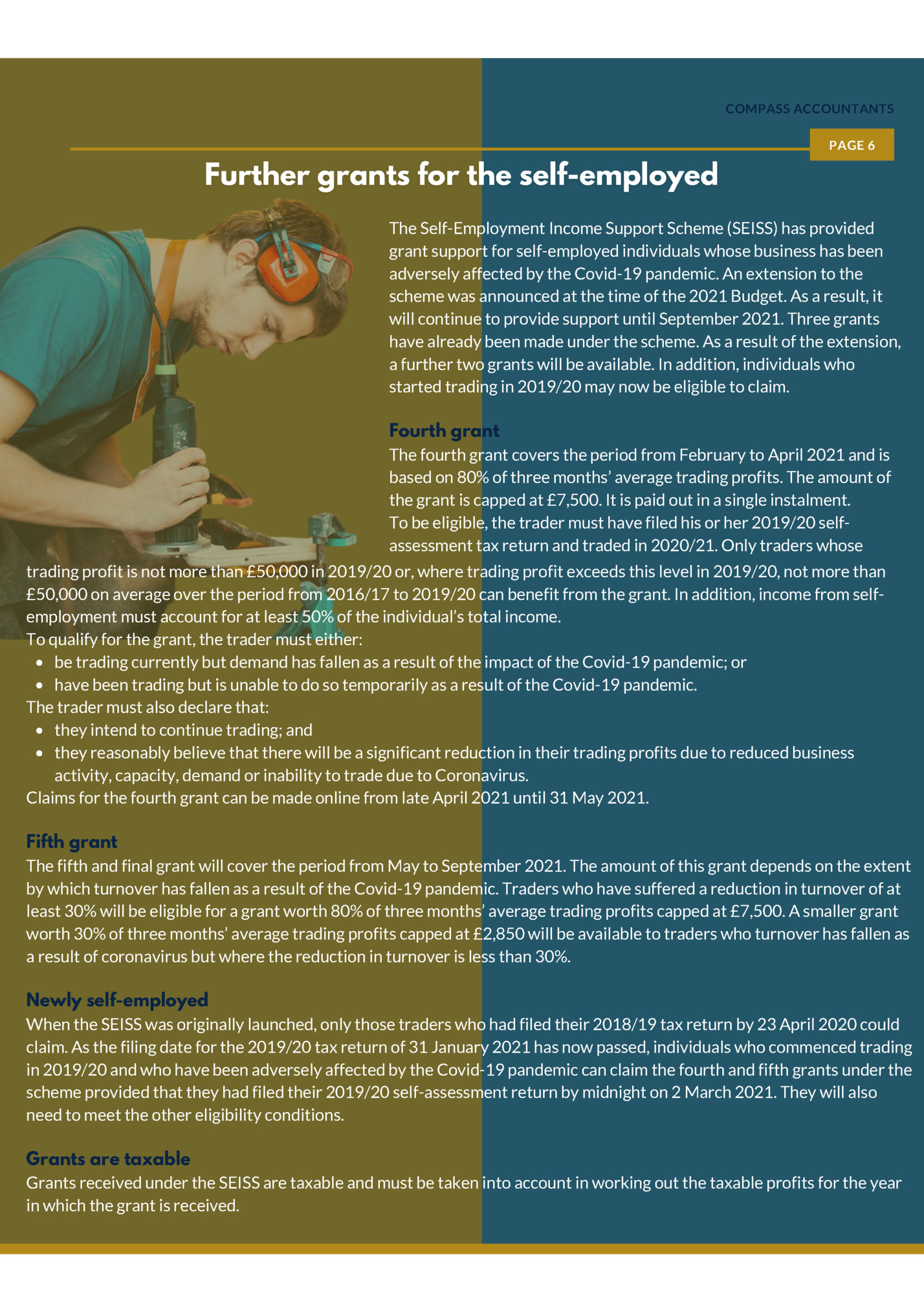
Tax allowances frozen until April 2026 The financial impact of the Covid-19 pandemic is unprecedented and borrowing levels in 2020/21 of 16.9% of GDP represent the highest level of peacetime borrowing. To meet some of this cost, the Chancellor, Rishi Sunak, announced in the 2021 Budget that various thresholds and allowances would remain at their 2021/22 levels until April 2026. Personal allowance The personal allowance is increased to £12,570 for 2021/22 – an inflationary increase of £70 over the 2020/21 level of £12,500. However, the allowance will remain at this level for 2022/23, 2023/24, 2024/25 and 2025/26. As incomes rise with inflation, people who currently do not pay tax may start to pay tax once their income rises above £12,570. Income tax rates and bands The basic rate band is increased to £37,700 for 2021/22. This means that where someone is in receipt of the personal allowance of £12,570, they will start paying higher rate tax once their income exceeds £50,270. This remains the case for tax years up to and including 2025/26. The basic rate band and higher rate threshold will remain at these levels until April 2026. As incomes rise in line with inflation, more people will pay tax at the higher and the additional rates. Tax is payable at the additional rate of 45% on taxable income in excess of £150,000. Capital gains tax annual exempt amount The capital gains tax annual exempt amount remains at £12,300 for 2021/22 and is frozen at this level until April 2026. However, there may be changes to capital gains tax on the horizon as this is something that the Government are looking at. National Insurance The upper earnings limit for Class 1 National Insurance contributions and the upper profits limit for Class 4 contributions are aligned with the rate at which higher rate tax becomes payable. Both are set at £50,270 for 2021/22. For Class 1 purposes, this is equivalent to £967 per week and £4,189 per month. These too will remain unchanged until April 2026. All other National Insurance thresholds will be reviewed at the appropriate time. Inheritance tax The nil rate band has been frozen at its current level of £325,000 since 2008/09. It will remain at this level up to and including 2025/26. The freezing of the threshold brings more estates within the ambit of inheritance tax. The residence nil rate band (RNRB) remains at its 2020/21 level of £175,000 for 2021/22. It too will remain at this level for the 2023/24 to 2025/26 years inclusive. The RNRB is reduced where the value of the estate is £2 million or above by £1 for every £2 by which the value of the estate exceeds £2 million. Pension lifetime allowance The pension lifetime allowance places a cap on the value of tax relieved pension savings. The tax relief on pension savings in excess of the lifetime allowance is recovered in the form of a 25% tax charge where the excess is taken as a pension and a 55% tax charge where the excess is taken as a lump sum. The lifetime allowance remains at £1,073,100 for 2021/22 and will stay at this level until April 2026. This will limit the ability of anyone with pension savings at or near this level to make further tax-relieved pension contributions during 2021/22 and the following four tax years.
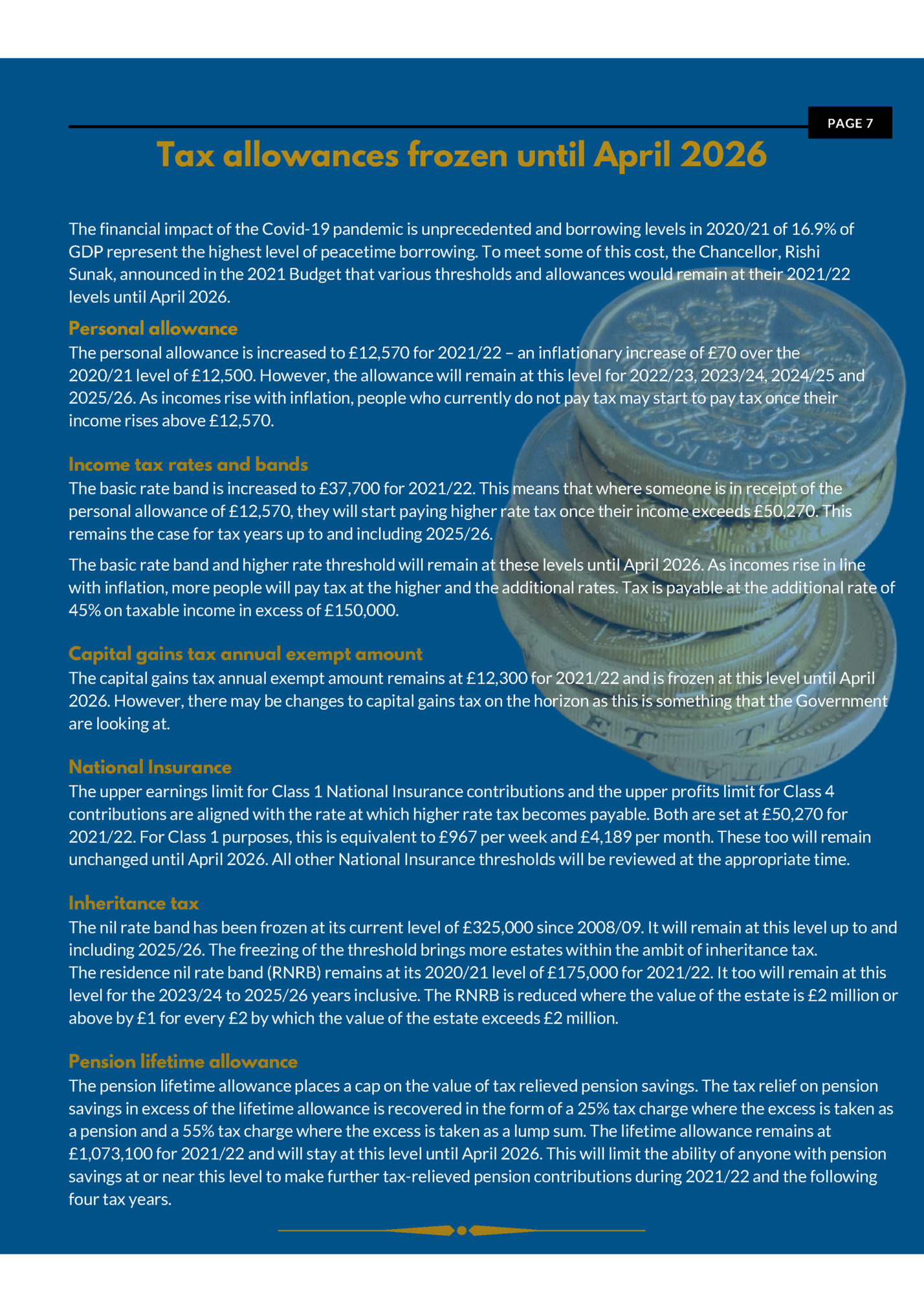
PAGE 8 My Journey in AccountancySarah McInnes Sarah McInnes is an Accountant on the Compass team- Here she talks about her journey in accountancy, how she gained her qualifications, and what it is about her profession that she most enjoys... I kind of fell into accountancy, I never intended or desired to be an accountant. I was working as an admin assistant for the telecoms company in Waterlooville and fancied a change. I looked through the newspaper (that’s when job ads didn’t involve expensive recruitment agents!) and found a tiny little advert looking for a bookkeeper. My first thought was ‘I could do that’ when in fact I didn’t actually know if I could. I went for the job and got it, about 2 years in they asked if I wanted to train as an accountant. I declined at first but then decided I would try it. I started training and have never looked back. Firstly, I got my CAT qualification (Chartered Accounting Technician), which is a necessary foundation. Many bookkeepers also get to technician level as it gives you a good basic knowledge of fundamental accounting terms and procedures. This took me about 2 years. I then moved on to ACCA, ideally, I would have liked to have completed ACA, but the practice where I worked was an ACCA practice. ACCA was hard -particularly as I was doing home study. I studied at home and then just before my exams (which were every June & December) I took a revision course which was usually a week in class with other students. Cont on pg 8

PAGE 9 Trying to get motivated to work at home was particularly difficult as I was in my early 20s and wanted to go out and party! I nearly gave up a few times, especially when I failed my last exam twice but kept going. I qualified in 2009 and obtained my Fellowship in 2015, after 5 years of being a full member. I am therefore, a FCCA. I didn’t pay to keep my CAT qualification so have dropped those letters. I found more people qualified as AAT which is the more popular technician level. CAT was not as popular. Obviously as I have gained more experience my job has evolved. I found things hard at first but had a good support network where I worked. I am glad I started working in a small practice and not one of the larger ones as I have managed to do a bit of everything and this helped my training. In larger firms you would generally do a small part of the work and then pass on to someone else or a manager but working in a small firm this was not an option. This means I have a vast experience in most aspects of my work and the work we carry out at Compass. I love my job now and enjoy helping people, giving advice and when we have trainees, I enjoy teaching them as much as possible. I love being an accountant and I am proud that I qualified. I particularly enjoy advising clients, especially when I know the advice I have given will be beneficial to their business. I am amazed by the amount of people who think I must be good at maths to be an accountant and I relish in telling them that’s not the case. My Dad taught me mental arithmetic and so I am not too bad at maths, but I wouldn’t be able to do a maths degree. If I could give anyone considering accountancy advice, I would say to stick with it, avoid cutting corners, and remember the basics. Whenever I am stuck I go back to basics. If you can remember the basics, you can do the job well.
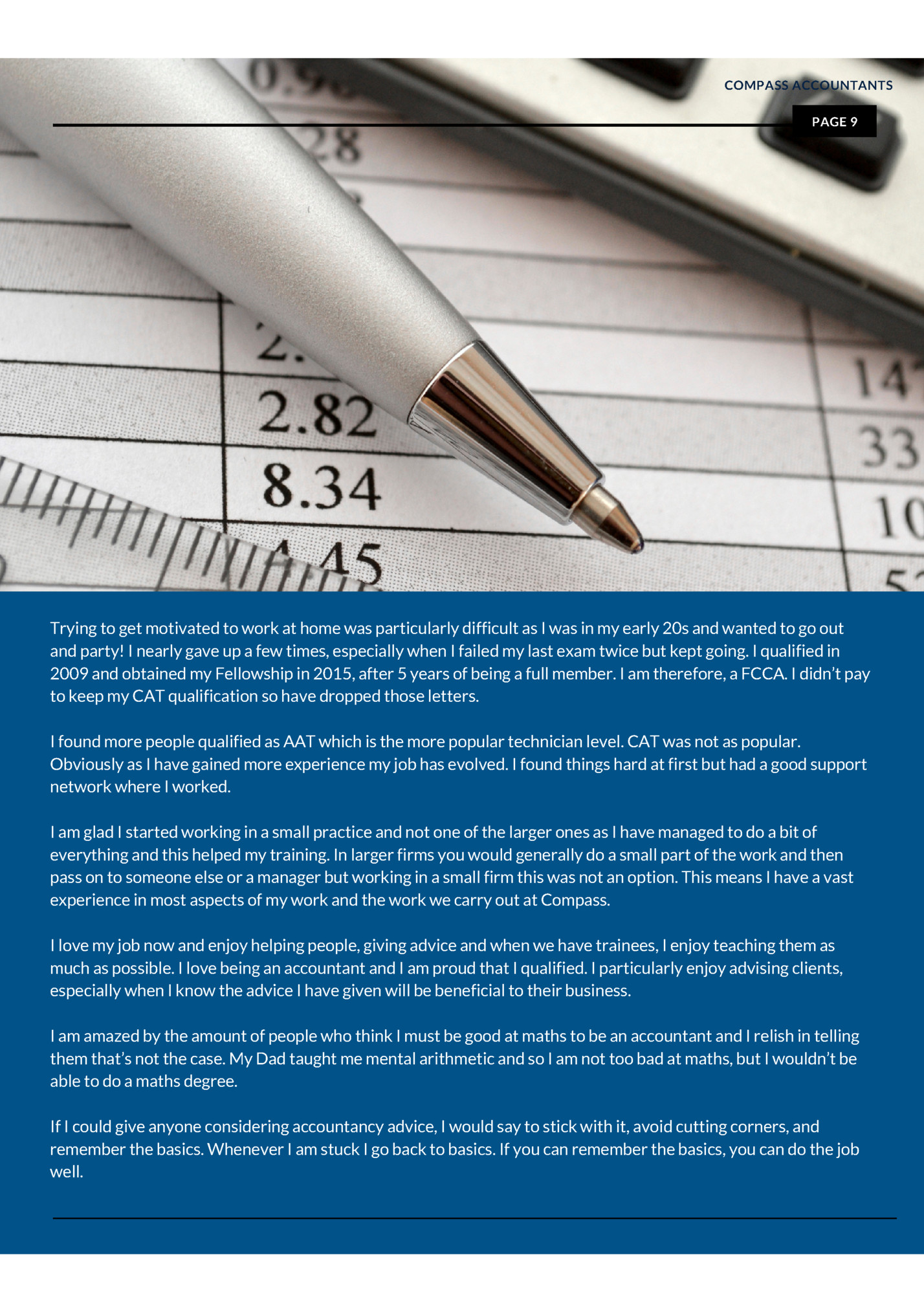
Fleepit Digital © 2021